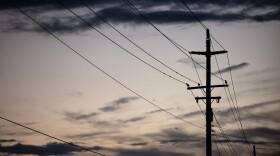The tide off the Chula Vista shoreline was quite low on Monday afternoon — a perfect opportunity for Heather Carroll to check out one of the Port of San Diego’s latest pilot projects designed to protect against erosion.
Carroll is the director of Environmental Conservation at the Port, which manages the San Diego Bay. The low tide revealed more than she was expecting to find.
“That's an upside-down jellyfish,” she said while standing feet-deep in the clear waters at the Chula Vista Wildlife Reserve. “Oh my gosh. I've never seen one.”
Shortly after, she spotted some eelgrass near the jellyfish that looked like it had just grown.
The presence of these living species, Carroll said, may be a good indication that oyster castles are working.
“We're definitely going to monitor,” she said. “I do think it helps make a nice, calm, protected environment for some of these creatures.”
In May, the Port installed 600 oyster castles as a way to increase biodiversity in an area that “has been manipulated so much over time to support infrastructure and our everyday uses,” Carroll said. They’re also used to protect the shoreline from erosion.
“Like many areas of the bay, this area will be impacted by sea level rise and tides and storm surge that has the potential to erode the shorelines,” she said.
These “castles” are similar to traditional construction blocks, but they are developed with recycled oyster shells and molds rough enough to encourage more native oysters to attach, according to the Port. Each is 12 inches long and wide and 8 inches high, and weighs about 35 pounds. Several dozen are stacked horizontally along the coastline and as many as three vertically.
Their purpose is to break up waves, lessening their impact on the coast. That reduced wave energy can then allow the structures to hold sand and sediment together.

The blocks provide shelter for new oysters and other marine organisms to attach and settle, becoming a living reef.
“Oysters are keystone species in the bay,” said Carroll. “They can actually process about 50 gallons of water per day. And when they do that, they filter out any sediments or contaminants that are in the water, which makes the water more clear and healthier, which then supports a lot of our other species, like eelgrass and fish and birds that utilize that environment.”
The oyster castles are part of a larger program at the reserve — the San Diego Bay Native Oyster Living Shoreline project — that the Port launched in 2021 to monitor wildlife growth and wave energy.
That effort involved installing a few hundred oyster reef balls, which are made of concrete, sand and shells.
The Port said that the reef ball elements would be expected to be left in place as habitat if successful or removed after five years of monitoring in 2026.
A technical advisory committee, composed of experts from the Universities of California, Davis and Santa Cruz, the state Coastal Commission and others, developed a success criteria. A Port project description said that it includes seeing native Olympia oysters at “statistically significantly higher densities” than other parts of the San Diego Bay with hard substrates, like large rocks used to protect against erosion.
Since their addition, Carroll said the Port has noticed more wildlife taking refuge in and around the reef balls and now the castles.
“We've seen dozens of bird species, sitting on top of the reef balls and the oyster castles picking little things off that they can eat,” said Carroll. “We've found octopus, have dens inside the reef falls where they can rest.”
Carroll says the Port will continue to monitor their effectiveness and explore other areas where they can offer protection from erosion.





